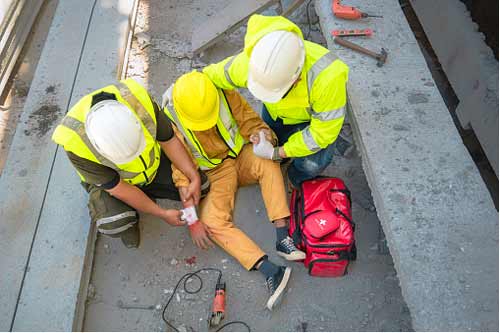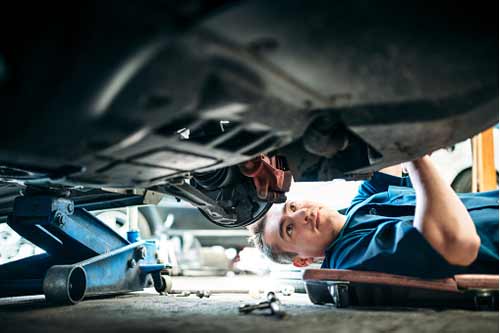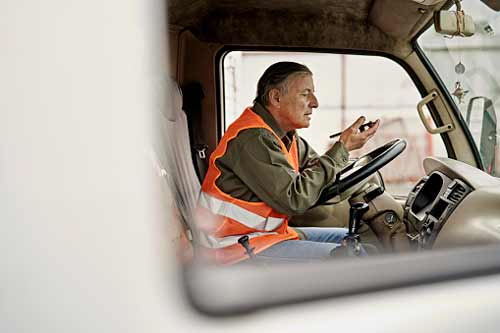Dangerous jobs are often necessary and can be found in a variety of industries.
Workers succumb to work-related injuries and diseases from a wide range of safety risks and hazards.
But in which occupations do these injuries and deaths take place? What are the most dangerous occupations to work in?
In this article, we reveal the UK’s most dangerous jobs and most common workplace deaths. These dangerous jobs help maintain the everyday function of society.

The Most Dangerous: Construction
Unsurprisingly, it is a construction that is deemed to be the most dangerous career in the UK. While high scaffolding, cranes, and large machinery are all essential for many of these risky industries to work. Last year saw 39 construction workers killed following accidents on sites https://bit.ly/3vWYswv The absolute number of workplace deaths in construction is four times higher than the average across other industries. But this is partly due to the high number of people working in the industry.
When it comes to dangerous workplaces construction sites are ranked among some of the most hazardous Being surrounded by heavy machinery, materials being loaded and unloaded, and unique hazards and obstacles seemingly at every turn, it can be difficult to avoid personal injury. Whilst some hazards are easy to spot, others are less so. Here are some common causes of injury on a construction site.
Fire and explosions
On any given construction site there is a host of electrical systems, half-completed piping as well as flammable materials and chemicals. It’s common knowledge that electricity and water don’t mix, but it’s still an issue on construction sites https://bit.ly/3vVJRkZ
Falls
Unfortunately, the risk of falls, slips, and trips comes with the territory of working on a building site. It’s not uncommon to find floor openings, incomplete roofs, and surfaces that don’t have strong support structures. The reliance on ladders and scaffolding also increases the risk of falling.
Getting stuck
Construction sites are filled with heavy machinery, vehicles and large, heavy materials.
Getting caught in or between any of the above can result in the worker getting crushed, and potentially fatally wounded.
Overdoing it
Anyone who has worked on a construction site will tell you that it is physically demanding.
Whether you are lifting heavy materials in blistering heat, braving blustery conditions to ensure the job is finished, or working overtime to ensure the deadline is met, working on a construction site can be tough.
Carrying out manual labour in all weather conditions can take a serious toll on a worker’s body.
Working in the sun for prolonged periods can result in heat stroke, which, in severe cases can lead to heart, brain, or kidney damage.
Meanwhile carrying out construction work in the winter months always carries the risk of hypothermia or frostbite which can lead to workers losing their fingers or toes.

A Close Second: Farming
Much agricultural work is, by its nature, physically demanding. The risk of accidents is increased by fatigue, poorly designed tools, difficult terrain, exposure to extreme weather conditions, and poor general health, associated with working and living in remote and rural communities.
Common accidents and hazards around the farm.
-
Heavy equipment
Tractors, plows, and other machinery are large and heavy and often require a lot of training to operate properly. Tractors tip over more easily than many people imagine and tractors are involved in approximately 44 percent of farming accidents. Perhaps the most baffling aspect of this is that most tractors do not include seatbelts.
-
Suffocation and Asphyxiation accidents
The grains that make our bread and pastries present a significant threat to farmers. Silos and other grain storage facilities have incredibly poor ventilation grains such as wheat and soybeans produce a fine powder that can make it difficult to breathe. As if that’s not terrifying enough, silos also present the opportunity for farmworkers to fall into the grain. Because silos can hold an incredible amount of grain, it’s pretty common for farmers to fall into the grains and suffocate as a result
Chemical Exposure
pesticides is not good for anyone to ingest. The product is often sprayed liberally onto crops using large machines and distribution methods. The chemicals linger in the air for a long time and are easily inhaled during the workday. During harvesting, these same chemicals come in contact with the skin, causing further exposure. Pesticide exposure can cause rashes, breathing issues, vomiting, and long-term lung issues.
Transportation incidents, which include tractor overturns were the leading cause of death for these farmers and farm workers.
-
Heart-related accidents
Heatstroke, dehydration, UV poisoning, and eye damage are related to the long days those farmers spend in the sun. While many farmers drink lots of water, the work is taxing on the body. The summer heat can become lethal and lead to health crises or cause workplace mistakes to happen.
-
Animal accidents
Many of us are often excited to see cows, horses, and sheep roaming around in their pastures. Though these animals are certainly cute, they can be dangerous to the farmers who care for them. It’s easy for a horse to spook or a cow to become agitated and kick whoever is nearby. The unpredictability of these animals regularly leads to severe injuries and accidents.

3. Manufacturing
The manufacturing industry employs millions of workers each year. While many of these workers enjoy a safe work environment, others suffer serious workplace injuries. The reality is the manufacturing industry is dangerous, and if employers aren’t following federal safety guidelines, workers will get hurt.
Manufacturing jobs are often the most dangerous jobs because of the products and machinery used in the processes. However, some types of manufacturing are more dangerous than others.
Workers use forging, stamping, bending, and other processes to shape metal. In order to do this, the metal needs to be heated to a very high temperature and workers often require powerful machines to do the work.
Manufacturing wood products involves using sharp cutting machines to carve the wood into the desired shape, food products are also sometimes treated with chemicals to achieve the desired colour.
https://www.hse.gov.uk/statistics/industry/manufacturing.pdf

4. Care & Nursing
From the onset of the COVID-19 pandemic, long-term care workers around the world have been at the centre of the crisis, caring for those most vulnerable to the disease in extremely high-risk environments. They work long hours in close proximity settings, some even moving into care homes to ensure they will not transmit the virus in or out.
These workers are in regular, close physical contact with dozens of residents every day, risking their own and families’ lives to provide treatment and care.

5. Waste Management
A waste operator is responsible for collecting residential refuse and recycling, moving, lifting, and loading heavy items and wheelie bins. You may also need to learn how to use a lifting mechanism to transfer refuse to the waste lorry and operate a waste compactor. Residential waste management and industrial and commercial waste disposal can be complicated processes, so a clear understanding of how to operate the machinery is vital.
Because of the danger involved in waste management jobs, facilities need to provide ample training to operators. The training requirements are established by the law and enforced by the Health and Safety Executive (HSE). Businesses need to make sure employees are appropriately trained, regardless of their educational or professional backgrounds.
The number of fatal injuries recorded in the waste and recycling sector has fallen for the third consecutive year.
https://www.hse.gov.uk/statistics/industry/waste-recycling.pdf

6. Office & Admin
You may think working in a comfy, climate-controlled office is safe and hazard-free, but there are many risks to your safety and health all around you.
Here are some of the most common office hazards:
-
Slips and trips
Wet floors, exposed cords, unstable work surfaces, uneven floors, loose rugs, and cluttered areas.
-
Ergonomic Injuries
Office workers spend many hours a day seated at a desk, working on a computer, resulting in ergonomic strains and other injuries related to posture and repetitive movement. These types of hazards can be difficult to detect.
-
Eye strain
Spending a large portion of your workday at the computer can cause eyestrain, according to the Mayo Clinic. Eyes may become dry and irritated, and workers may begin having trouble focusing. Light levels should be suitable for the work task—for instance, manual detail work may require higher levels of lighting, but staring at a computer monitor does not, the NSC said.
-
Stress
People who work in public admin or defense has one of the most dangerous jobs in the UK. Because this profession is so stressful! The majority of sickness in this occupation is due to stress, which is often linked to depression or anxiety.

7. Scaffolding and Roofing
Scaffolding is one of the most dangerous jobs in the country, and falling or injuries sustained by falling account for 29% of all workplace deaths.
Due to the nature of scaffolding and roofing, both must be secure before work takes place, and neither can suffer from not being so. Roofing is especially dangerous, as it can be slippery and unstable underfoot. Having co-workers close by to support you is one way you can help to ensure your safety. Test every bit of roofing or scaffold under foot before applying your full weight, and move slowly.
Working on roofs is a hazardous activity because it involves working at height. Roof work accounts for a quarter of all deaths in the construction industry
Main causes: the main causes of death and injury are falling from roof edges or openings, through fragile roofs, and through fragile roof lights.

8. Paramedic & Fire Fighters
Paramedics and firefighters face danger every time they’re called to an emergency. Close contact with blood and bodily fluids leaves paramedics vulnerable to contracting infectious diseases. Working in all types of indoor and outdoor environments exposes paramedics and firefighters to hazardous chemicals; materials and sounds that may lead to significant hearing loss; and psychological stresses. The exertion of carrying and lifting patients also takes a major physical toll, resulting in stress injuries that force them to miss work.

9. Mechanic
Vehicle maintenance and repair is the eighth deadliest job in the UK. In the five years leading to 2021, 20 people died. Risks in the role include being trapped by something collapsing and contact with machinery.
Workshops are full of tools, equipment, and other objects which, if left in the wrong places, could lead to slips and trips – which could result in hospital trips and long periods of time off work. Slips and trips are actually the most common risk in vehicle repair workshops.
There’s a real risk of objects falling from cars while mechanics are working underneath them. Worse still, car lifts or jacks could fail, with potentially fatal consequences.
Falls actually account for the largest number of fatalities and serious injuries in vehicle repair workshops. These include falls into inspection pits or from raised storage areas, ladders, or HGV and trailer units.
Lifting, moving, and carrying heavy and/or bulky items can lead to a number of accidents if the appropriate precautionary steps aren’t taken. Manual handling should be a last resort when no other option is possible.
A vehicle repair workshop is full of fuel and other flammable materials that must be treated with respect. Incidents related to fire and explosion are often caused by the mishandling of fuel, grinding or welding near fuel tanks or other flammable materials, or the misuse of flammable liquids like degreasers.

10. Lorry Driver
With 47 deaths in the last 5 years, lorry driving is one of the most dangerous occupations. Being struck by a moving vehicle is a common cause of death within the occupation.
Other risk factors of being a lorry driver include obesity, high blood pressure, unhealthy diets, lack of exercise, lack of sleep, and stress. This could lead to all kinds of disorders such as cardiovascular, sleep apnoea, and diabetes which are also linked to an increase in the risk of accidents.
The health problems associated with driving could be a contributory factor in drivers falling asleep at the wheel. In April 2018 a confidential survey by Unite of its HGV drivers found that 29 percent admitted having fallen asleep at the wheel of a lorry.
Make Safety your priority
Is your industry included in the list above? Even if it isn’t, improving your team’s safety should continue to be a goal this year, saving your workers from injury and death (and the accompanying emotional impact), as well as saving your organization from the significant costs of worker time off and potential litigation. Setting and reaching safety goals have a long and deep impact on both the team and organisation, benefiting other important areas like productivity, employee mental health, and as you’ll read below, the company’s work culture.
